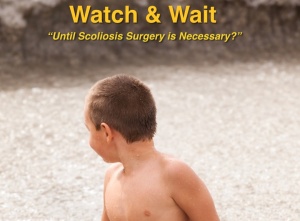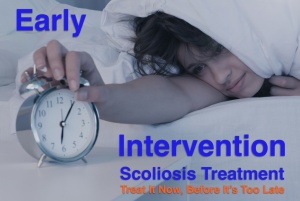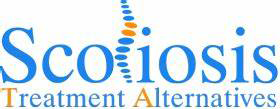Pediatric Scoliosis Treatment
If your child has just been diagnosed with scoliosis chances are the doctor has recommended that you just “watch and wait” for now. That probably doesn’t seem right to you justify to yourself by saying “Well, what do I know, he’s the expert.”, so you follow his recommendations.
Still you something doesn’t seem right to you. You think to yourself: “Doing nothing doesn’t seem like a treatment” and you would be correct about that.
Think about it, you’ve just been told that your child has been diagnosed with early stages of a scoliosis. In essence, you’ve just been given an early alarm warning you that things could get much worse soon. So why would you just “Watch and Wait” until surgery is needed?
Your parental instincts are telling you that should act now before it gets worse but let’s face it, you’ve reluctantly chosen to listen to the experts simply because you don’t know what else is out there, which is why you are here. You are not alone. Listen to what the mother of one of our patients has to say about “Watch & Wait”.Scoliosis Treatment Options
Let’s explore some of the benefits of the options available for treating your child’s scoliosis, including “watch and wait”.
Option 1 – Watch and Wait

Watch and Wait is by far the most common recommendation made today for pediatric scoliosis treatment by doctors after scoliosis is first detected. Instead of doing something to prevent the progression, it’s recommended that you do nothing but have x-rays taken of your child’s spine every 6 months to a year to monitor how much the abnormal curvatures progress.
Despite all the advances in medical science in other areas this is the standard of care in the orthopedic world when it comes to pediatric scoliosis treatment in the U.S. The concept behind them is somewhat archaic. : “Let’s see if the abnormal curvatures in the spine stabilize on their own. If they don’t stabilize then we may have to place them in a hard scoliosis brace or even do surgery.” seems to be the order of the day.
A large part of the reason most orthopedic scoliosis surgeons will take a wait and see attitude when it comes to pediatric scoliosis treatment is they have to offer like rigid bracing or surgical fusion are highly intrusive or invasive to your child so they feel they should be avoided if at all possible. They assure you that once your child stops growing they no longer run the risk of their scoliosis progressing, which is only a half truth. Yet, from that prospective “Watching and Waiting” may sound like a reasonable idea on the surface.
Still, your gut tells you that you should be doing something, but what?
Your instincts are right. The drawbacks of this approach is that it’s fatalistic and if the curvature is left uncorrected could ultimately lead to a scoliosis surgery. This “do nothing” approach stands by and lets the scoliosis progress unabated, instead of intervening early with an effective pediatric scoliosis treatment is that it does nothing to halt or reverse a potentially devastating condition during the early stages, when it is most correctable.
Unfortunately, in this country scoliosis is managed almost exclusively by orthopedic surgeons and their treatment for scoliosis involves using metal hardware to fuse the spine once the curve has passed 45 degrees or more. They are generally unfamiliar with other types of rehabilitative scoliosis treatment.
In his book called The Psychology of Science Abraham Maslow developed the concept called “The Law of the Instrument”. In it he discussed the tendency in science and medicine to have over-reliance on familiar tools. He once wrote: “It is tempting, if the only tool you have is a hammer, to treat everything as if it were a nail.”
Since a surgeon cuts they tend to narrow the scope of their vision to only see patient’s that need surgery. After all, they have spent decades developing and honing that skill and those are the patients that they can help with their “hammer”, but don’t let them fool you into thinking there are no other tools that can help your child’s scoliosis.
The statistical reality is that only 1 – 2% of patients with scoliosis will ever need surgery, so what about the rest? Why are they being managed by an orthopedic surgeon?
Don’t wait until the scoliosis worsens to the point that only a hammer will work. Waiting only allows for the curves to progress to the point that either hard bracing or surgical intervention becomes inevitable.
Option 2 – Wait Until The Scoliosis Progresses To Start Treatment
The risk for progression is greatest around puberty or other times of rapid growth. The accelerated growth that occurs during this period of development tends to drive the curvatures and is the single most dangerous time for an idiopathic scoliosis to worsen.
While the risk for a rapid progression of scoliosis is greatest during adolescents, once a scoliosis passes the 25 – 30 degree mark gravity begins to take advantage of it. From this point on, if nothing is done to stablize the spine, then there is a risk of progression due to the constant forces of gravity pulling the scoliosis over. This can lead to a slow progression of a abotu 1 degree per year that can extend into adulthood.
In this scenderio that would mean that with this type of slow progression a child with a 30 degree curvature at age 15 has a potential of developing a 50 degree curvature by the time they are 35 years old. (40 -45 degrees is the theshold most surgeons consider for surgery).
In fact, in a comprehensive scientific literature review for the Scoliosis Journal titled The Transformation of Spinal Curvature into Spinal Deformity: Pathological Processes and Implications for Treatment researchers Martha C. Hawes and Joseph P. O’Brien conclude the following:
“A significant body of research now has demonstrated that, whatever the initial trigger that induces a spinal curvature, asymmetric loading of the spinal axis produces biomechanical forces that can account for most, if not all, progression of the spinal deformity (9-17, 57-62,80) The data, taken together, suggests that there is an threshold for continuous asymmetrical loading that must be reached before vertebral changes occur, and that transient loading will not foster asymmetric growth leading to deformity… Structural damage to bone and disc can occur very early in the development of even minor curves (49). Yet the damage can be reversed entirely if steps are taken to reverse the loading imbalance while significant growth potential remains (19,40,58) These data suggests that preventing a state of continuous asymmetric loading in an early stage of scoliosis will prevent the development of spinal deformities.”
As the curvature progresses it become increasing more difficult to correct and there is that there is a tipping point for scoliosis curvatures that once the spine reaches about 30 degrees gravity will take advantage of asymmetry the scoliosis causing abnormal loading on the spine that can create permanent changes in the bones, if not caught early. This in turn can cause more aggressive progression of these abnormal curvatures due to the imbalanced structures of the spine.
While there is no guarantee that a curvature less than 30 degress will not progress either, especially during the periods of rapid growth around puberty, there is one thing that is certain. Smaller curves, when left uncorrected, can progress into bigger more aggressive curves with the potential to wreak irreversible havoc on a spine and make scoliosis surgery a self fulfilling prophecy. That is, unless some type of specific pediatric scoliosis treatment can be done to stablize the spine in the first place.
Scoliosis Progression In Adulthood
For a female with scoliosis there are 3 times in her life that she is at risk for a rapid progression of her scoliosis. The first time is one that she has likely recently gone through or may be approaching, that is puberty. While it is true that the risk for rapid progression reduces significantly once a child reaches skeletal maturity, for a female with scoliosis there are two additional times in her life that there is an increased risk for rapid progression for her scoliosis.
Puberty
When a girl reaches puberty her body is undergoing significant hormonal changes during a period of rapid growth. This combination can cause an uneven growth between the growth plates on the right and left sides, one side grows too much and the other side has a delay in its growth. This delay in growth on one side results in a reduced height at one side that creates the initial tipping of the vertebra which if left uncorrected results in the formation of a scoliosis curvature. The continued growth of the spine during this time makes it the most dangerous period of time where a scoliosis is most likely to progress.
Pregnancy
When a woman is pregnant she has a hormone in her body called Relaxin, which is there to allow for the pelvic ligaments to relax so that the pelvis can widen as she delivers the baby. The problem is that Relaxin doesn’t just relax the pelvic ligaments, it relaxes all the ligaments in the spine. If a woman with scoliosis hasn’t done anything to stabilize her spine then chances are because of the distortion of her spine she is resting on her ligaments which can stretch causing the scoliosis to worse during pregnancy.
Menopause
During menopause the drop in estrogen tends to lead to bony demineralization. If the spine is not in good balance or supported properly by the muscles surrounding the spine then the vertebra can collapse further as a result of the biomechanics imbalances, which can worsen the curvature.
While it may be hard to imagine your child as an adult, it’s important to begin the process of gaining muscular stability in the spine right now to avoid the problems that could occur later in life, if left untreated.
Option 3 – Early Intervention Scoliosis Treatment

A watching and waiting approach only delays treatment and reduces the opportunity for stopping the curves from progressing early on, when they are the most manageable. Intervention done as early as possible to prevent further progression is the key. Don’t just do nothing and stand by waiting for the alarm bells to ring.
Take action now and investigate other early intervention options such as the SpineCor Dynamic Scoliosis Brace, Nu-Schroth Scoliosis Exercise and A.R.T. for Scoliosis that can help halt the progress of the curvatures and in many cases actually reduce the scoliosis, especially when treatment is started in the beginning stages when they are most manageable.


Useful info. Hope to see more good posts in the future.
Hi,
I am a chiropractor who is interested in getting certified in your scoliosis treatment protocol. Please advise if you offer any training or certification program.
Dr. Sean Hajo
HI Actually i am writting to you so interested to have a spine cor brace for my 12 years old boy who is suffering from idiopathic thoracic scoliosis thoracic curve cobb angle about 60 degree
so please if you could kindly recommend me what to do. iam looking forward to hear from you soon
is this spine cor brace indicated for my child and if it is how can i get it many thanks
mr omar
Tripoli Libya
How it cost
Militaru,
The cost will vary depending on which of our treatments you need. What I would suggest is that you give us a call at (800) 943-1254 for a Free Scoliosis Phone Consultation to find out which of our treatments are right for your scoliosis, then they can give you an accurate idea of the costs in your case.
Hello.Do you have an office in Asia?I am in China.Where is my nearest office?
Tracy,
Sorry, we don’t have any offices in Asia but there is a doctor in Singapore that I know who does similar type of non-surgical scoliosis treatment. His name is Dr. Kevin Lau. Here is his website: https://hiyh.info/en_SG/home/
Hi! We live here in Maryland, can someone direct us to a nearest facility? My daughter is 10 and I would like to give this a try. Thanks!
Our office in Manhattan would be the closest to you. Click Here to Schedule a Free Scoliosis Phone Consult to find out if our treatment are right for your daughter.